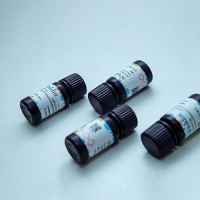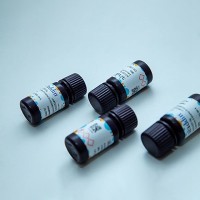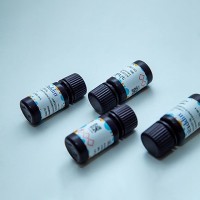Synthesis of Alkyne‐ and Azide‐Modified Oligonucleotides and Their Cyclization by the CuAAC (Click) Reaction
互联网
- Abstract
- Table of Contents
- Materials
- Figures
- Literature Cited
Abstract
The Cu(I)?catalyzed alkyne?azide cycloaddition (CuAAC) reaction has been used to synthesize cyclic mini?DNA duplexes. The reaction is carried out on 5??alkyne?3??azide?labeled hairpin loop oligonucleotides and proceeds in high yield under mild conditions in as little as 5 min. The resultant duplexes have very high thermal stability and their CD spectra are characteristic of normal B?DNA. Curr. Protoc. Nucleic Acid Chem. 35:4.33.1?4.33.21. © 2008 by John Wiley & Sons, Inc.
Keywords: Click chemistry; CuAAC reaction; oligonucleotide cyclization; mini?duplex
Table of Contents
- Introduction
- Basic Protocol 1: Synthesis of Propargylamidohexanyl Phosphoramidite
- Basic Protocol 2: Synthesis of Hexynyl Phosphoramidite
- Basic Protocol 3: Synthesis of Succinimidyl‐4‐Azidobutyrate
- Basic Protocol 4: Oligonucleotide Synthesis, Purification, Analysis, and Cyclization
- Reagents and Solutions
- Commentary
- Literature Cited
- Figures
- Tables
Materials
Basic Protocol 1: Synthesis of Propargylamidohexanyl Phosphoramidite
Materials
Basic Protocol 2: Synthesis of Hexynyl Phosphoramidite
Materials
Basic Protocol 3: Synthesis of Succinimidyl‐4‐Azidobutyrate
Materials
Basic Protocol 4: Oligonucleotide Synthesis, Purification, Analysis, and Cyclization
Materials
|
Figures
-

Figure 4.33.1 Synthesis of phosphoramidite monomer S.4 and incorporation at the 5′‐end of an oligonucleotide. View Image -

Figure 4.33.2 Synthesis of phosphoramidite monomer S.6 and incorporation at the 5′‐end of an oligonucleotide. View Image -

Figure 4.33.3 Synthesis of active ester S.8 and labeling of the amino group at the 3′‐end of an oligonucleotide. View Image -

Figure 4.33.4 CuAAC reaction of hairpin oligo H‐2 to give cyclic oligo C‐2. View Image -

Figure 4.33.5 Gel electrophoresis analysis of hairpin loops (H; purified) and the click reaction mixture (C) on a 20% polyacrylamide/7 M urea gel 3 hr at a constant power of 20 W, using 0.09 M TBE buffer, pH 8.0. Oligonucleotide sequences are shown in Table . Reprinted from El‐Sagheer et al. () with permission. View Image -

Figure 4.33.6 Mixed injection of equal quantities of purified hairpin loop (H) and cyclic (C) oligonucleotides on capillary electrophoresis. Cyclization of the hairpin loop to give the corresponding cyclic oligonucleotide was confirmed by injection (0.2 OD/100 µL) of each sample individually followed by mixed injection of both samples. ssDNA 100‐R gel, Tris/borate/7 M urea were used (kit no. 477480) on a Beckman Coulter P/ACE MDQ Capillary Electrophoresis System using 32 Karat software, using the following parameters: UV: 254 nm, injection voltage: 10.0 kV, and separation voltage: 9.0 kV (45.0 min duration). Reprinted from El‐Sagheer et al. () with permission. View Image -

Figure 4.33.7 Reversed‐phase HPLC of the reaction mixture for cyclization of hairpin loops H‐1 and H‐2 to give cyclic C‐1 and C‐2. The x axis is time from start of integration (3 min). The y axis is UV absorbance at 280 nm (C‐1) and 292 nm (C‐2). Reprinted from El‐Sagheer et al. () with permission. View Image -

Figure 4.33.8 Gel electrophoresis of crude reaction mixture of cyclization of hairpin H′‐2 using 2 eq of Cu(I) to give the cyclic oligo C′‐2 with varying reaction times. Lane 1: hairpin H′‐2. Lanes 2 to 5: time course of the reaction, shown at 5, 30, and 120 min, respectively. View Image -

Figure 4.33.9 Gel electrophoresis of crude reaction mixture of cyclization of hairpin H‐2 to give the cyclic oligo C‐2 using varying equivalents of Cu(I). Lane 1: hairpin H′‐2. Lanes 2 to 7: reaction with decreasing amounts of Cu(I), shown at 200, 20, 10, 5, 2.5, and 1.25 eq Cu(I), respectively. View Image -

Figure 4.33.10 Derivatives of UV melting curves of hairpin and cyclic oligonucleotides. Melting curves were measured on Cary 400 Scan UV‐Visible Spectrophotometer (Varian) at 5 to 7 µM oligonucleotide in 10 mM phosphate buffer/200 mM NaCl, pH 7.0, to which increasing amounts of formamide were added. Spectra were recorded at 272 nm. T m values were calculated using Cary Win UV Thermal application Software. Reprinted from El‐Sagheer et al. () with permission. View Image -

Figure 4.33.11 CD spectra of cyclic oligonucleotides. Spectra were measured on a Jasco J‐720 spectropolarimeter at 5.0 µM oligonucleotide in 10 mM phosphate buffer/200 mM NaCl, pH 7.0. Spectra were recorded at 100 nm/min with a response time of 1 sec and a bandwidth of 1 nm. A buffer baseline was subtracted from each spectrum to give zero ellipticity at 320 nm. Reprinted from El‐Sagheer et al. () with permission. View Image
Videos
Literature Cited
| Literature Cited | |
| Alvira, M. and Eritja, R. 2007. Synthesis of oligonucleotides carrying 5′‐5′ linkages using copper‐catalyzed cycloaddition reactions. Chem. Biodivers. 4:2798‐2809. | |
| Carboni, B., Vaultier, M., and Carrie, R. 1987. Chemoselectivity of the reaction of dichloroboranes with functional azides—Efficient functionalized secondary amine synthesis. Tetrahedron 43:1799‐1810. | |
| Chan, T.R., Hilgraf, R., Sharpless, K.B., and Fokin, V.V. 2004. Polytriazoles as copper(I)‐stabilizing ligands in catalysis. Org. Lett. 6:2853‐2855. | |
| Collman, J.P., Devaraj, N.K., and Chidsey, C.E.D. 2004. “Clicking” functionality onto electrode surfaces. Langmuir 20:1051‐1053. | |
| El‐Sagheer, A.H., Kumar, R., Findlow, S., Werner, J.M., Lane, A.N., and Brown, T. 2008. A very stable cyclic DNA mini‐duplex with just two base pairs. Chembiochem. 9:50‐52. | |
| Escaja, N., Gomez‐Pinto, I., Rico, M., Pedroso, E., and Gonzalez, C. 2003. Structures and stabilities of small DNA dumbbells with Watson‐Crick and Hoogsteen base pairs. Chembiochem. 4:623‐632. | |
| Giusto, D.A., Knox, S.M., Lai, Y., Tyrelle, G.D., Aung, M.T., and King, G.C. 2006. Multitasking by multivalent circular DNA aptamers. Chembiochem. 7:535‐544. | |
| Kanan, M.W., Rozenman, M.M., Sakurai, K., Snyder, T.M., and Liu, D.R. 2004. Reaction discovery enabled by DNA‐templated synthesis and in vitro selection. Nature 431:545‐549. | |
| Kool, E.T. 1996. Circular oligonucleotides: New concepts in oligonucleotide design. Annu. Rev. Biophys. Biomol. Struct. 25:1‐28. | |
| Kumar, R., El‐Sagheer, A., Tumpane, J., Lincoln, P., Wilhelmsson, L.M., and Brown, T. 2007. Template‐directed oligonucleotide strand ligation, covalent intramolecular DNA circularization and catenation using click chemistry. J. Am. Chem. Soc. 129:6859‐6864. | |
| Langley, G.J., Herniman, J.M., Davies, N.L., and Brown, T. 1999. Simplified sample preparation for the analysis of oligonucleotides by matrix‐assisted laser desorption/ionisation time‐of‐flight mass spectrometry. Rapid Commun. Mass Spectrom. 13:1717‐1723. | |
| Lee, I.K., Ahn, J.D., Kim, H.S., Park, J.Y., and Lee, K.U. 2003. Advantages of the circular dumbbell decoy in gene therapy and studies of gene regulation. Curr. Drug Targets 4:619‐623. | |
| Nicolaou, K.C., Hwang, C.K., Marron, B.E., Defrees, S.A., Couladouros, E.A., Abe, Y., Carroll, P.J., and Snyder, J.P. 1990. Bridging of macrodithionolactones to bicyclic systems—Synthesis and modeling of oxapolycyclic frameworks. J. Am. Chem. Soc. 112:3040‐3054. | |
| Park, S.H., Pistol, C., Ahn, S.J., Reif, J.H., Lebeck, A.R., Dwyer, C., and LaBean, T.H. 2006. Finite‐size, fully addressable DNA tile lattices formed by hierarchical assembly procedures Angew. Chem. Int. Ed. Engl. 45:735‐739 [Published erratum appears in Angew. Chem. Int. Ed. Engl. 45:6607]. | |
| Punna, S., Kuzelka, J., Wang, Q., and Finn, M.G. 2005. Head‐to‐tail peptide cyclodimerization by copper‐catalyzed azide‐alkyne cycloaddition. Angew. Chem. Int. Ed. Engl. 44:2215‐2220. | |
| Rostovtsev, V.V., Green, L.G., Fokin, V.V., and Sharpless, K.B. 2002. A stepwise Huisgen cycloaddition process: Copper(I)‐catalyzed regioselective “ligation” of azides and terminal alkynes. Angew. Chem. Int. Ed. Engl. 41:2596‐2599. | |
| Rothemund, P.W.K. 2006. Folding DNA to create nanoscale shapes and patterns. Nature 440:297‐302. | |
| Seeman, N.C. 2003. DNA in a material world. Nature 421:427‐431. | |
| Seeman, N.C. and Belcher, A.M. 2002. Emulating biology: Building nanostructures from the bottom up. Proc. Natl. Acad. Sci. U.S.A. 99:6451‐6455. | |
| Tumpane, J., Sandin, P., Kumar, R., Powers, V.E.C., Lundberg, E.P., Gale, N., Baglioni, P., Lehn, J.M., Albinsson, B., Lincoln, P., Wilhelmsson, L.M., Brown, T., and Norden, B. 2007. Addressable high‐information‐density DNA nanostructures. Chem. Phys. Lett. 440:125‐129. | |
| Zengmin, L., Seo, T.S., and Ju, J. 2004. 1,3‐Dipolar cycloaddition of azides with electron‐deficient alkynes under mild condition in water. Tetrahedron Lett. 45:3143‐3146. | |
| Zhang, L., Long, H., Schatz, G.C., and Lewis, F.D. 2007. Synthesis and properties of nicked dumbbell and dumbbell DNA conjugates having stilbenedicarboxamide linkers. Org. Biomol. Chem. 5:450‐456. |







